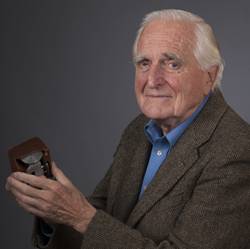
American engineer, inventor, computer and Internet pioneer, and ACM A.M. Turing Award recipient Douglas Engelbart died at his home in Atherton, CA, last week. Engelbart succumbed to kidney failure after a lengthy illness, according to his wife, Karen O’Leary Engelbart.
The ACM Digital Library hosts a number of papers by Engelbart, including two that are part of "Boosting Our Collective IQ: A Selection of Readings," a book including some of his key papers:
- Toward Augmenting the Human Intellect and Boosting our Collective IQ
- Knowledge-Domain Interoperability and an Open Hyperdocument System
Engelbart was drafted out of Oregon State College (now Oregon State University) into the U.S. Navy during World War II. After leaving the Navy he returned to Oregon State, where he received his bachelor’s degree in Electrical Engineering in 1948. He later enrolled in graduate school at the University of California, Berkeley (UC Berkeley), where he received his master’s degree in Electrical Engineering in 1953, and his Ph.D. in that discipline in 1955.
Engelbart taught at UC Berkeley for a year before leaving to launch the startup company Digital Techniques. After a year of trying to commercialize some of his doctoral research on storage devices, he took a position with Stanford Research Institute (now SRI International), where he worked on magnetic devices and the miniaturization of electronics, eventually receiving more than a dozen patents for his work.
At SRI, Engelbart founded the Augmentation Research Center (ARC), where the work was focused on developing new collaboration and information processing tools. There, he and his team developed bitmapped screens, the computer mouse, hypertext, and initial steps towards the graphical user interface.
Despite receiving a patent in 1970 for the computer mouse (which he’d developed with lead engineer Bill English several years earlier), Engelbart said he had never received any royalties for that invention.
In 1968, Engelbart demonstrated a number of ARC’s inventions at the "Mother of All Demos," a session of the Fall Joint Computer Conference in San Francisco that actually was called "A research center for augmenting human intellect." Among other things, the 1,000 computer industry professionals in attendance saw early versions of videoconferencing, word processing, hypermedia, object addressing and dynamic file linking, revision control, and a collaborative real-time editor.
In the 1970s, ARC was acquired by Tymshare, and hired Engelbart as Senior Scientist. Tymshare eventually was purchased by McDonnell Douglas, and in 1984 Engelbart retired from that organization.
Engelbart teamed up with his daughter Christina in 1988 to found the Bootstrap Institute, with the goal of presenting his ideas on the potential to enhance human ability to solve complete, urgent problems in a series of seminars at Stanford University. This eventually became the non-profit Bootstrap Alliance, which also offered consulting and small-scale collaborations.
Also in 1988, Engelbart and daughter Christina founded the Doug Engelbart Institute, which promotes Engelbart’s notion of increasing Collective IQ – how groups can solve important problems collectively – using strategic bootstrapping to speed progress. The Institute is now based at SRI International headquarters in Menlo Park, CA.
Engelbart was the first recipient of the SoftQuad Award for Excellence (later was named the Yuri Rubinsky Memorial Award) at the Fourth International World Wide Web Conference in Boston in 1995. In 1996, the Franklin Institute presented Engelbart with its Certificate of Merit, which was followed in 1999 by the Benjamin Franklin Medal in computer and cognitive science. In 1997, he received the Lemelson-MIT Prize, and the ACM A.M. Turing Award. In 1998, Engelbart received the CHI Lifetime Achievement Award from ACM SIGCHI.
U.S. president Bill Clinton presented Engelbart with the National Medal of Technology and Innovation, that nation’s highest technology award, in 2000. The following year, he was awarded the Lovelace Medal by the British Computer Society. The organization Computer Professionals for Social Responsibility honored him in 2005 with the Norbert Wiener Award for Social and Professional Responsibility "for being a pioneer of human-computer interface technology, inventor of the mouse, and social-impact visionary."
Engelbart was named a Fellow of the Computer History Museum in 2005, an NMC Fellow of the New Media Consortium in 2009, and was inducted into IEEE Intelligent Systems’ AI’s Hall of Fame in 2011. Also in 2011, he received Yale University’s first honorary doctorate in Engineering and Technology.
He is survived by his wife, writer/producer Karen O’Leary Engelbart, and four children.



Join the Discussion (0)
Become a Member or Sign In to Post a Comment